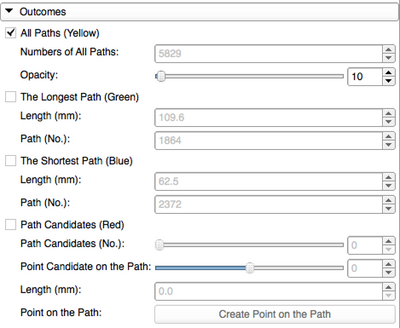Difference between revisions of "Documentation/Nightly/Modules/PercutaneousPathDesigner"
| (9 intermediate revisions by the same user not shown) | |||
| Line 12: | Line 12: | ||
Author: Atsushi Yamada, Shiga University of Medical Science (SUMS), Japan<br> | Author: Atsushi Yamada, Shiga University of Medical Science (SUMS), Japan<br> | ||
| − | Contributors: Junichi Tokuda (Brigham and Women's Hospital), Koichiro Murakami (SUMS), Shigeyuki Naka (SUMS), Tohru Tani (SUMS)<br> | + | Contributors: Junichi Tokuda (Brigham and Women's Hospital), Koichiro Murakami (SUMS), Soichiro Tani (SUMS), Shigeyuki Naka (SUMS), Tohru Tani (SUMS)<br> |
Contact: Atsushi Yamada, <email>ayamada@belle.shiga-med.ac.jp</email><br> | Contact: Atsushi Yamada, <email>ayamada@belle.shiga-med.ac.jp</email><br> | ||
{{documentation/{{documentation/version}}/module-introduction-row}} | {{documentation/{{documentation/version}}/module-introduction-row}} | ||
| Line 35: | Line 35: | ||
|} | |} | ||
| − | PercutaneousPathDesigner is a Slicer4 module designed to | + | The PercutaneousPathDesigner module is a Slicer4 module designed to visualize bundles of needle path candidates to avoid blood vessels, bones and specific anatomies and specify skin entry points on the path candidates. |
| − | The bundles of path candidates | + | The bundles of path candidates and the skin entry point on each path in the bundles are calculated based on a target point, a skin model and an obstacle model. |
| − | + | This bundle expression might help you grasp safety paths easily. | |
| − | This bundle expression | + | It is also possible to evaluate the each path on the bundles based on the length and the trajectory comparing with the longest and the shortest paths. |
| − | + | The location of the skin entry point on each path could be modified by extending and shrinking the path. | |
| − | The location of the skin entry point | + | The skin entry point on each path could be output as a MarkupFiducial List. |
| − | The | + | After getting the outcomes, you can clean up the models and transform matrixes generated from this module. |
| − | |||
<!-- | <!-- | ||
Here comes a description what the module is good for. Explain briefly how it works and point to the [[documentation/{{documentation/version}}/Modules/{{documentation/modulename}}#References|references]] giving more details on the algorithm. | Here comes a description what the module is good for. Explain briefly how it works and point to the [[documentation/{{documentation/version}}/Modules/{{documentation/modulename}}#References|references]] giving more details on the algorithm. | ||
| Line 53: | Line 52: | ||
<!-- ---------------------------- --> | <!-- ---------------------------- --> | ||
{{documentation/{{documentation/version}}/module-section|Use Cases}} | {{documentation/{{documentation/version}}/module-section|Use Cases}} | ||
| − | PercutaneousPathDesigner is a useful tool for planning needle | + | The PercutaneousPathDesigner module is a useful tool for planning needle and probe paths. |
| − | Percutaneous thermal ablations including radio frequency, microwave and cryotherapy | + | Percutaneous thermal ablations including radio frequency, microwave and cryotherapy require such probe trajectories to avoid blood vessels, bones and specific anatomies to reach the probes to target tumors. |
| − | Needle biopsy also requires safety | + | Needle biopsy also requires safety paths to gather multiple tissue. |
| − | For these cases, this module can help to obtain the path candidates based on the target point, a segmented model | + | For these cases, this module can help to obtain the path candidates based on the target point, a segmented obstacle model to avoid and another segmented model which represents skin entry surface. |
| Line 70: | Line 69: | ||
* Parameters panel | * Parameters panel | ||
| − | ** Target Point requires MarkupsFiducial List created in Markups Module which has | + | ** Target Point requires a MarkupsFiducial List created in Markups Module which has one target markup. |
| − | ** Output Fiducial List requires MarkupsFiducial List created in Markups Module which has no markups. | + | ** Output Fiducial List requires a MarkupsFiducial List created in Markups Module which has no markups. |
| − | ** Skin Model requires a model which represents a skin, that is | + | ** Skin Model requires a model which represents a skin, that is a surface consists of the candidates of the needle entry points. |
| − | *** Opacity Slider can change the opacity parameter | + | *** Opacity Slider can change the opacity parameter for the Skin Model selected. |
| − | ** Obstacle Model requires a model which represents | + | ** Obstacle Model requires a model which represents the obstacle needle paths should avoid. |
*** Opacity Slider can change the opacity parameter for the Obstacle Model selected. | *** Opacity Slider can change the opacity parameter for the Obstacle Model selected. | ||
| − | ** Create Paths button starts | + | ** Create Paths button starts calculating path candidates from target point to the skin model to avoid the obstacle model. |
{| | {| | ||
| Line 83: | Line 82: | ||
* Outcomes panel | * Outcomes panel | ||
| − | ** All Paths (Yellow) check button | + | ** All Paths (Yellow) check button visualizes all path candidates shown as the yellow bundles of lines. |
*** Opacity Slider can change the opacity parameter for the yellow bundles. | *** Opacity Slider can change the opacity parameter for the yellow bundles. | ||
** The Longest Path (Green) check button displays the longest path as the green line. | ** The Longest Path (Green) check button displays the longest path as the green line. | ||
** The Shortest Path (Blue) check button displays the shortest path as the blue line. | ** The Shortest Path (Blue) check button displays the shortest path as the blue line. | ||
** The Path Candidate (Red) check button displays the one of the yellow bundles as the red line. | ** The Path Candidate (Red) check button displays the one of the yellow bundles as the red line. | ||
| − | *** Path Candidate (No.) Slider can select | + | *** Path Candidate (No.) Slider can select a red line from the yellow bundles. |
*** Point Candidate on the Path Slider can extend and shrink the selected red line from the skin entry point. | *** Point Candidate on the Path Slider can extend and shrink the selected red line from the skin entry point. | ||
| − | *** Create Point on the Path button | + | *** Create Point on the Path button adds the entry position to the Output Fiducial List you set in the Parameters panel. |
{| | {| | ||
| Line 98: | Line 97: | ||
* Configurations panel | * Configurations panel | ||
** Delete Paths button erases the all models created by this module. | ** Delete Paths button erases the all models created by this module. | ||
| + | ** Delete Transforms button erases the transforms created by this module except the marker transforms. | ||
<!-- | <!-- | ||
| Line 111: | Line 111: | ||
*[http://www.na-mic.org/Wiki/index.php/2014_Project_Week:PercutaneousApproachAnalysis Percutaneous Approach Analysis project in 2014 Winter Project Week ] | *[http://www.na-mic.org/Wiki/index.php/2014_Project_Week:PercutaneousApproachAnalysis Percutaneous Approach Analysis project in 2014 Winter Project Week ] | ||
*[https://github.com/ayamada0614/PercutaneousPathDesigner Source code repository] | *[https://github.com/ayamada0614/PercutaneousPathDesigner Source code repository] | ||
| + | *[http://www.na-mic.org/publications/item/view/1266 SPL Abdomina Atlas (Used in examples)] | ||
<!-- ---------------------------- --> | <!-- ---------------------------- --> | ||
Latest revision as of 04:04, 11 August 2014
Home < Documentation < Nightly < Modules < PercutaneousPathDesigner
|
For the latest Slicer documentation, visit the read-the-docs. |
Introduction and Acknowledgements
|
This work is supported by NA-MIC, NCIGT, Slicer Community, and Shiga University of Medical Science in Japan. Author: Atsushi Yamada, Shiga University of Medical Science (SUMS), Japan | |||||||
|
Module Description
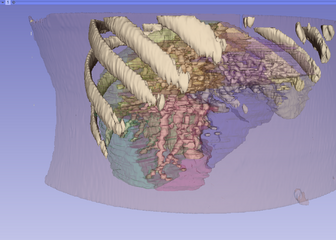
|
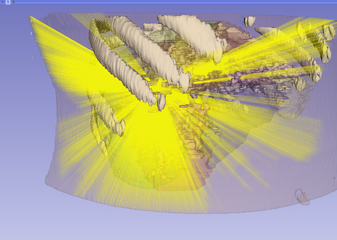
|
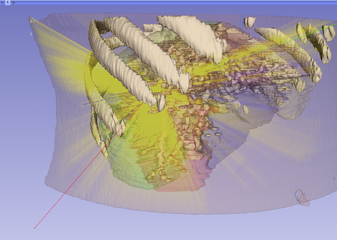
|
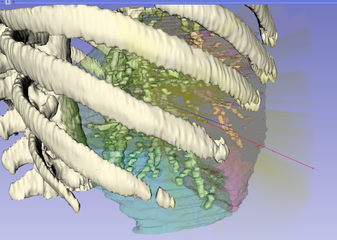
|
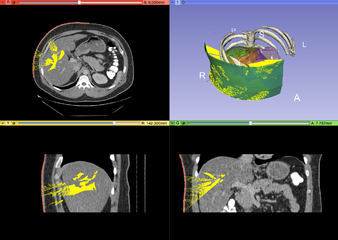
|
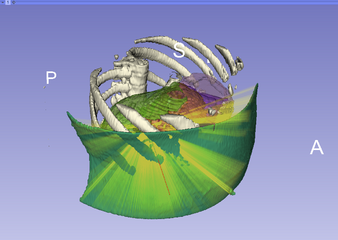
|
The PercutaneousPathDesigner module is a Slicer4 module designed to visualize bundles of needle path candidates to avoid blood vessels, bones and specific anatomies and specify skin entry points on the path candidates. The bundles of path candidates and the skin entry point on each path in the bundles are calculated based on a target point, a skin model and an obstacle model. This bundle expression might help you grasp safety paths easily. It is also possible to evaluate the each path on the bundles based on the length and the trajectory comparing with the longest and the shortest paths. The location of the skin entry point on each path could be modified by extending and shrinking the path. The skin entry point on each path could be output as a MarkupFiducial List. After getting the outcomes, you can clean up the models and transform matrixes generated from this module.
Use Cases
The PercutaneousPathDesigner module is a useful tool for planning needle and probe paths. Percutaneous thermal ablations including radio frequency, microwave and cryotherapy require such probe trajectories to avoid blood vessels, bones and specific anatomies to reach the probes to target tumors. Needle biopsy also requires safety paths to gather multiple tissue. For these cases, this module can help to obtain the path candidates based on the target point, a segmented obstacle model to avoid and another segmented model which represents skin entry surface.
Tutorials
N/A
Panels and their use
- Parameters panel
- Target Point requires a MarkupsFiducial List created in Markups Module which has one target markup.
- Output Fiducial List requires a MarkupsFiducial List created in Markups Module which has no markups.
- Skin Model requires a model which represents a skin, that is a surface consists of the candidates of the needle entry points.
- Opacity Slider can change the opacity parameter for the Skin Model selected.
- Obstacle Model requires a model which represents the obstacle needle paths should avoid.
- Opacity Slider can change the opacity parameter for the Obstacle Model selected.
- Create Paths button starts calculating path candidates from target point to the skin model to avoid the obstacle model.
- Outcomes panel
- All Paths (Yellow) check button visualizes all path candidates shown as the yellow bundles of lines.
- Opacity Slider can change the opacity parameter for the yellow bundles.
- The Longest Path (Green) check button displays the longest path as the green line.
- The Shortest Path (Blue) check button displays the shortest path as the blue line.
- The Path Candidate (Red) check button displays the one of the yellow bundles as the red line.
- Path Candidate (No.) Slider can select a red line from the yellow bundles.
- Point Candidate on the Path Slider can extend and shrink the selected red line from the skin entry point.
- Create Point on the Path button adds the entry position to the Output Fiducial List you set in the Parameters panel.
- All Paths (Yellow) check button visualizes all path candidates shown as the yellow bundles of lines.
- Configurations panel
- Delete Paths button erases the all models created by this module.
- Delete Transforms button erases the transforms created by this module except the marker transforms.
Similar Modules
N/A
References
- Percutaneous Approach Analysis project in 2014 Winter Project Week
- Source code repository
- SPL Abdomina Atlas (Used in examples)
Information for Developers
| Section under construction. |




